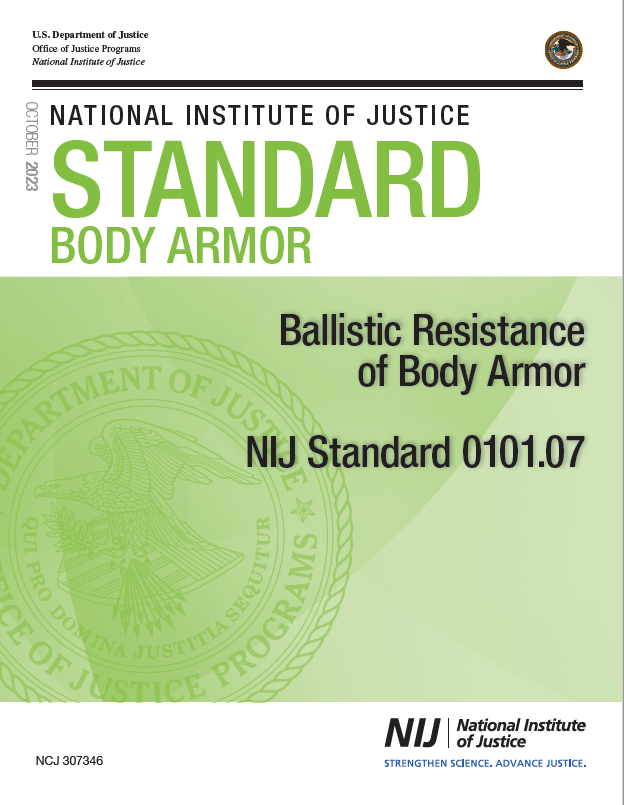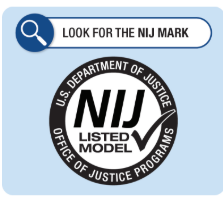A little over a decade ago, Officer Ann Carrizales of the Stafford Police Department in Fort Bend County, Texas, was shot in the face and chest at extremely close range by a suspect she was pursuing. Fortunately, Officer Carrizales’ personally fitted body armor saved her life, although she sustained serious injuries that later required surgery. However, thanks to her vest, she was able to continue the chase, apprehend the suspect, and eventually return home safely to her husband and children.[1]
Life-altering events like Officer Carrizales’ remind me why the National Institute of Justice (NIJ) works so diligently to create body armor standards — why we run a comprehensive and rigorous body armor testing program and produce a publicly available list of every product tested that is compliant with current standards.
NIJ’s body armor program is best understood in three parts: performance standards, compliance testing, and a compliant product list. NIJ’s performance standard has been revised seven times since the first version was published in 1972 by our precursor agency, the National Institute of Law Enforcement and Criminal Justice. Periodic updates allow NIJ to keep pace with the ever-evolving weapons threats that law enforcement officers encounter. The most recent performance standard, NIJ Standard 0101.07, The Ballistic Resistance of Body Armor, was released in November 2023, the first update since July 2008 (Figure 1).
In this iteration of the standard, NIJ harmonized laboratory testing procedures and practices relevant to ballistic testing. The work was a collaboration among several agencies, including the U.S. Army, the National Institute of Standards and Technology, ballistics laboratories, body armor manufacturers, materials suppliers, and other stakeholders. Over several years, these groups produced a suite of testing methods and laboratory practices through ASTM International, a standards developer that publishes thousands of standards for many industries. NIJ used the ASTM standards as the building blocks of NIJ Standard 0101.07, adding improvements to the test methods for armor designed for women. It also augmented testing of how well the armor resists penetration and how deeply a bullet can deform the vest, which can cause blunt-force injuries to officers even when the vest isn’t fully penetrated.
NIJ also administers a body armor certification program, the Compliance Testing Program, to test commercially available products for protection against common handgun, rifle, and stab threats. Accredited labs test products for compliance and determine whether the products meet NIJ's minimum performance standards. The program enables U.S. law enforcement and corrections agencies to know which body armor meets minimum performance requirements before they buy their personal protective equipment.[2] NIJ’s Compliance Testing Program is completely voluntary; manufacturers are responsible for submitting their products to the program for testing.
In our numerous conversations with law enforcement and other stakeholders, I have heard loud and clear that standards and testing are great, but their impact is limited if no one knows about them. If a product is compliant, NIJ adds it to the Compliant Products List and the product is allowed to display the NIJ trademarked seal (Figure 2). If law enforcement agencies do not know to check for the NIJ seal and do not refer to the Compliant Products List before they purchase equipment, entire police forces could be in the line of fire without properly vetted protection.[3]
Programs like the Patrick Leahy Bulletproof Vest Partnership help reinforce the importance of properly vetted gear by reimbursing states, local governments, and federally recognized tribes for up to fifty percent of the cost of body armor vests purchased for law enforcement officers, but only if the vests are on the Compliant Products List.
Checking the Compliant Products List is also the best way to ensure that vests are appropriate for the specific needs of the officers they are meant to protect. For example, corrections officers are more likely to require stab-resistant armor, tactical units may require hard plates in their vests, and shift officers often need soft body armor. Procurement officers should understand that just because a product is compliant with one kind of threat, it will not be equally resistant to all types of threats. Each product is separately tested for the many different types of threats law enforcement officers encounter. It is imperative that officers wear the appropriate gear for the threats they are most likely to face.
A few months ago, Sheriff’s Deputy Joe Kill of the Ramsey County, Minnesota Law Enforcement Center, was shot while in pursuit of a suspect.[4] Like Officer Carrizales, Deputy Kill’s body armor absorbed shrapnel from rifle fire; although the shot displaced his ribs, his vest spared his life. And, like Officer Carrizales, he was able to return to his family thanks to his properly vetted body armor.
We recognize that law enforcement officers put their safety on the line every day for the greater good of our communities. An alarming 466 officers were assaulted or injured by firearms in 2023.[5] This is what drives NIJ to continually improve and enhance our body armor standards. Our institute’s diligent work helps ensure the continued protection of law enforcement agents, like Deputy Kill and Officer Carrizales, who can rely on our guidelines and testing to feel confident their personal protective equipment will keep them safe.



